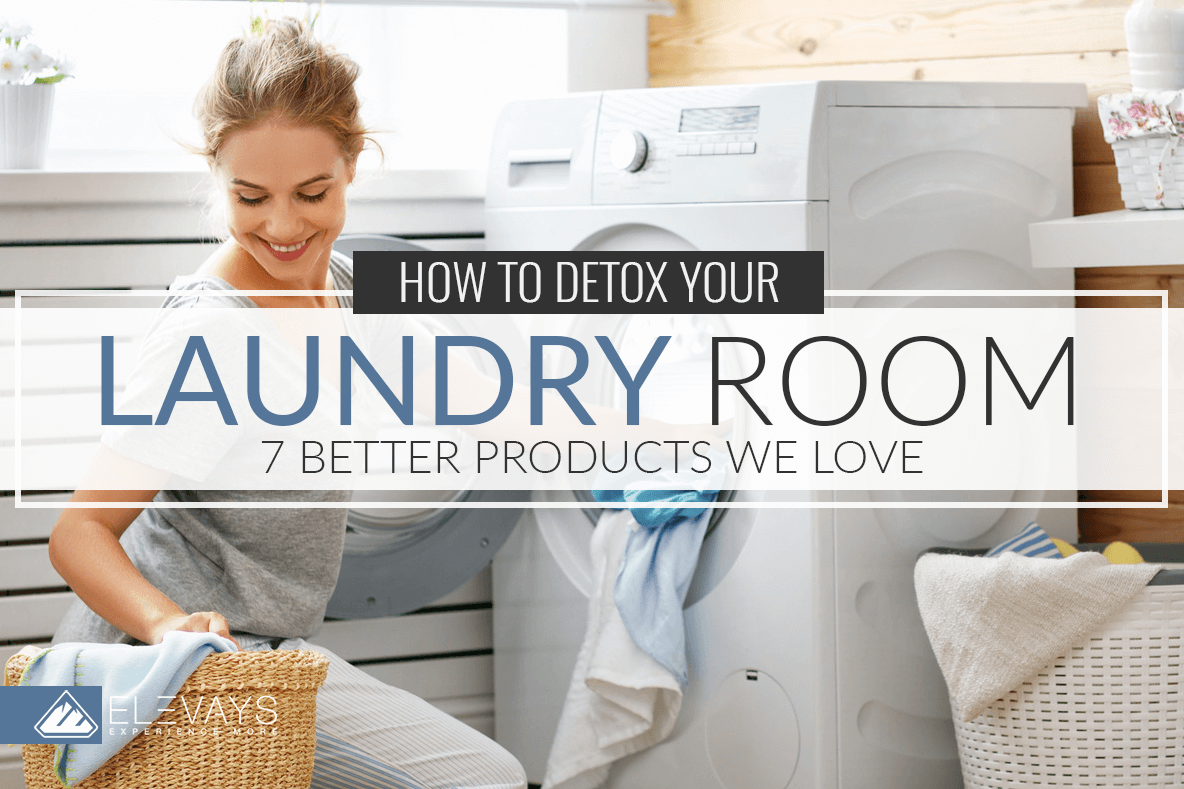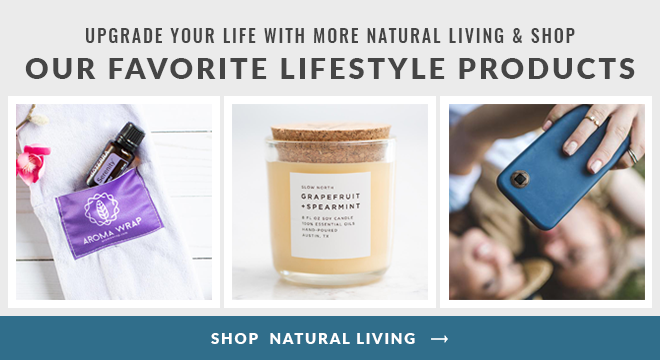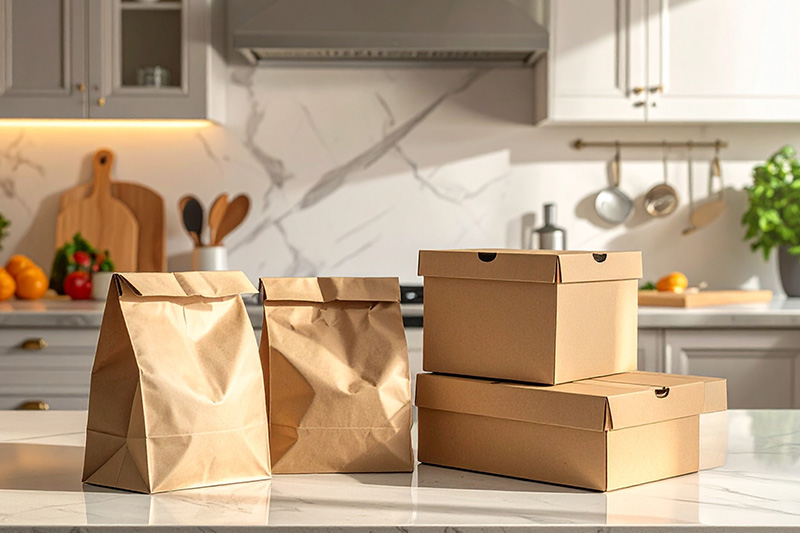We spend more time in bed, asleep than we do almost anywhere else–and we spend 24 hours in our clothes! But what if your clothes (and your sheets, blankets, and towels) aren’t just wrapping you and your family up in that fresh-laundry feeling, but instead delivering harmful toxins straight to your skin and into your body?
Unfortunately, our laundry rooms are often potent sources of toxins. It can be difficult to find a non toxic laundry detergent even if we’re using brands that are advertised as “green” or “natural.”
TRUTH BOMB:
You’re
Already killing it!
If You Were More Consistent With Your Wellness Routine, You’d Be Unstoppable.
Since we spend so much time in and around textiles that have been treated with detergents, softeners, and stain fighters, it’s imperative that we identify the harmful endocrine disruptors, carcinogens, and other toxins hiding in those products–and kick them out of our homes!
Good News About Non Toxic Laundry Detergent
I used to think that using a non toxic laundry detergent meant my clothes would never be clean or smell good again, but the good news is that’s just not true! Non toxic laundry detergent can be safe and effective. I’ve discovered a whole arsenal of powerful stain-fighting, non toxic laundry detergents that work for a variety of families, washers, and needs, and I’m listing them below.
Before I do that, however, I want to make it clear why there’s so much at stake–and why the laundry room is one of the most important rooms in your house to detox.
Why Does My Family Need Non Toxic Laundry Detergent?
Let’s look at an example of what very well might be on your laundry room shelf right now, to find out if it’s the non toxic laundry detergent you hope it is: Tide 2X Pure Essentials Liquid Detergent.
It’s a common detergent found in laundry rooms all over the country. It claims to be free of skin irritants, it smells fantastic (you can get it in Lemon Verbena), it’s affordable, and because it’s concentrated, it’s cost effective.
Sounds great, right? Unfortunately, it’s not. Let’s take a look at the ingredient list.
One of the first things we find in Tide 2X Pure Essentials is sodium borate. It’s a common ingredient in laundry products, despite the fact that it can be toxic for pregnant mothers and cause problems for young babies (and adults) who have sensitive skin.
In fact, sodium borate gets an F from the Environmental Working Group (EWG) (1) for documented concerns over developmental and reproductive toxicity, as well as some lesser concerns over its relationship with skin allergies, irritation, asthma, and the respiratory system.
Even more concerning? This so-called natural product is found in many trusted laundry detergents, including Mrs. Meyer’s, Tide, Babyganics, The Honest Co., and even Whole Foods Market and its 365 Everyday Value brand.
We Can’t Rely on Brands
Some of these brands have other great products (I list a product from The Honest Co. below that is a non toxic laundry detergent), but this underscores how important it is to read and understand labels for ourselves.
Sodium borate is worrisome enough, but if we take another look at our Tide detergent’s ingredient, we find another offender: ethanolamine.
Ethanolamine also gets an F from the EWG (2) thanks to serious concerns over its impact on the respiratory system and other organs, as well as a lower level of concern about its effects on the nervous system and the potential to cause skin irritation and an allergic response.
Finally (and maybe most alarming) is the synthetic fragrance Tide uses, which makes it one of the most toxic laundry detergent brands, in spite of its popularity. Synthetic fragrance has a long history of causing problems for consumers and it shows up just about everywhere these days, including in our makeup, face wash, household and personal care products.
Why is Fragrance So Harmful When it Comes to Non Toxic Laundry Detergent?
We all want a natural laundry detergent that leaves clothes smelling fresh, but fragrance isn’t all it’s cracked up to be. Synthetic fragrances smell good, of course, but they also help to mask the smells of other chemicals. For example, diethanolamine, another common toxic laundry detergent ingredient, smells like rotten fish or ammonia (3).
What’s worse is that, in addition to masking the gross ingredients or emitting carcinogenic air pollutants into our home, they are completely unregulated. The FDA allows an extremely broad range of synthetic chemicals to be classified as fragrances on the product’s ingredient list (4).
On the surface, this is so the brand doesn’t have to give away trade secrets, but what it also means is that we, the consumers, are left in the dark, because the truth is we do know what’s in many synthetic fragrances, and it’s not good.
Good Fragrances and Bad Fragrances
Most people are surprised to learn that there’s a huge difference between naturally-occurring fragrances, like those found in essential oils, and synthetic fragrances. Plant-derived fragrances have a pleasant aroma (without inducing a headache!) and have been used therapeutically for centuries.
I have personally used essential oils and their amazing aromas to promote relaxation, kill a breakout, and make my home smell wonderful and inviting! Synthetic fragrance, however, isn’t so peaceful.
In 2011, four researchers from the University of Washington in Seattle compared dryer vent emissions from washing and drying laundry. The control group used zero products, the first test group used a detergent that contained fragrance, and the third group used both detergent and dryer sheets that were fragranced (5).
When the study was completed, the authors found the following in the fragrance groups:
- Over 25 VOCs (volatile organic compounds–these are considered air pollutants)
- High concentrations of acetaldehyde, acetone, and ethanol
- Seven hazardous air pollutants (HAPs) (two were carcinogenic and classified by the US Environmental Protection Agency as having no safe level of exposure)
The Problem With Styrene
In addition to VOCs, HAPs, and carcinogens, synthetic fragrance can include styrene and phthalates. The National Toxicology Program (NTP) reported that styrene was “reasonably anticipate to be a human carcinogen” (6). In 2014, the NTP’s finding on styrene was confirmed by the Academy’s National Research Council, a multi-government collaboration between scientists (6).
You and I wouldn’t know styrene (which is also found in cigarette smoke, auto exhaust, and styrofoam) was in our laundry detergent unless we had a mass spectrometer or gas chromatograph because those are the only instruments that will detect it (6).
Sadly, this is just one reason fragrances don’t belong in non toxic laundry detergent; phthalates are another reason.
Phthalates: Banned in Europe But Still Used in the United States?
Phthalates, also included in the FDA’s fragrance classification, are even more alarming than styrene. Again, you won’t usually find them listed outright on your laundry detergent since they can hide behind the fragrance label (though they can also be listed as DEP, DEHP, or DBP) (7).
Their use in cosmetics has been banned outright in Europe (7), but their known links to cancer, endocrine disruption, and reproductive and developmental problems haven’t slowed them down here in the United States!
Here’s just a tiny example of the damage they can cause:
- Phthalates can disrupt hormones in unborn and breastfeeding children when the mother is exposed to them when pregnant or breastfeeding (this can even take place during critical developmental periods) (8)
- Phthalate exposure in utero has been linked to neurological disorders as well as ADHD and autism (9, 10)
- There is a strong link between male and female infertility and exposure to phthalates (11)
- Phthalates have been shown to cause cancer in animal studies, and are considered carcinogenic by the EPA (11)
You’re probably as shocked as I was when I first grasped phthalates’ dangers, especially considering how widely they’re used, but you probably won’t be shocked to learn that synthetic fragrances can also cause allergic reactions on your skin and make breathing more difficult, which is troubling if you already have asthma or other respiratory problems (13, 14, 15).
A truly non toxic laundry detergent shouldn’t excacerbate other health concerns, but fragrances are among the most common allergens across the world and can cause issues ranging from migraines to dermatitis.
The bottom line: if your detergent lists fragrance on the ingredient list, it is not a non toxic laundry detergent.
Softer Clothes, But at What Cost?
Laundry detergent is not the only thing to detox in your laundry room. Fabric softeners and dryer sheets also have to be taken into consideration.
Yes, using an in-wash fabric softener or a dryer sheet results in softer, better-smelling clothes, but what if the chemicals you’re coating your sheets, towels, and pajamas in are as bad as those found commonly in laundry detergents?
Fabric softeners contain huge amounts of fragrances, which, as you now know, are full of nasty ingredients like phthalates, styrene, and VOCs. Plus, you can expect to find preservatives, colorants, or colors listed on the label. These ingredients, like fragrances, are barely regulated and can cause all types of problems, including cancer and marine life toxicity (16).
Fabric softeners can also contain quaternary ammonium compounds, which are also known by the following names (17):
- distearyldimonium chloride
- diethyl ester dimethyl ammonium chloride
- hydroxyethyl methyl ammonium methyl sulfate
- biodegradable fabric softening agents
- cationic surfactant
Whatever they’re called, these compounds can cause cancer, allergic reactions, and respiratory problems, so it’s best to avoid these altogether.
Think of Bleach as Harmless? Think Again!
Many of us probably grew up seeing our parents wield that ubiquitous, white and blue jug of Clorox bleach, but bleach is not as innocent as it sounds. In fact, it can be deadly! When mixed with ammonium, which is found in glass cleaner and urine, bleach produces chloramine gas, which can cause fluid in the lungs, coughing and nausea, chest pain, and major irritation to the eyes, throat, and nose (18).
Chloramine gas isn’t the only byproduct you can get by combining bleach with another ingredient. Bleach combined with rubbing alcohol or acetone creates chloroform, which the Center for Disease Control (CDC) considers a probable carcinogen (19).
Alarming Outcomes
Bleach also can turn into chloroform when it’s combined with the organic matter in water. The CDC recognizes the dangers of chloroform in a paper dating back to 1997 (20). It explains the levels of chloroform found in the air we breathe, the water we drink, and the food we eat. Continuing to use bleach contributes to these problems, as chloroform might collect in your shower or on your clothes.
Inhaling bleach as you pour it (or even clean with it) can also mean serious lung irritation, and the vapors from chlorine gas are just as bad, causing symptoms such as chemical pneumonitis and asthma (the Association of Occupational and Environmental Clinics considers bleach an asthmagen) (21, 22).
The Best Non Toxic Laundry Detergent for Your Family
Fortunately, not all laundry detergents are toxic. There are many, many non toxic laundry detergents available on the shelves (and online) today. The best part is that they are safe without compromising results.
Here are a few of the brands we’ve used as a family (and loved!). The products I’ve listed are free from the harmful chemicals I’ve already discussed above, so you feel confident that they’re both effective and toxin-free.
1. Charlie’s Soap Laundry Powder
If you cloth diaper, you’ve probably seen Charlie’s Soap Laundry Powder pop up in lists of the best non toxic laundry detergent for cloth diapering families. It’s known for being able to handle hard water, tough diapers, and all the kinds of issues you probably run into on the regular, especially if you have kids–blood, organic stains, chocolate, etc.
I love it for how affordable it is (you only need a teaspoon per wash!) and the fact that it only has three ingredients but somehow manages to handle even heavy-duty smells and dirt. The EWG gives it an A rating, and so do we–no fragrances or other unsavory ingredients.
I also use and like Charlie’s Soap Oxygen Bleach. It works well and it’s without chlorine.
Special note: many of Charlie’s Soap products get great ratings from the EWG, but several don’t. Be careful and read your ingredient list!
2. Seventh Generation Natural Laundry Detergent Powder and Packs, Free and Clear
Unlike Charlie’s soap, which can be difficult to find in your local store, Seventh Generation products are likely to be at your local Target, Trader Joe’s, Sprouts, or wherever you shop weekly for groceries.
Not all Seventh Generation products are non toxic (I stay away from the liquid laundry detergent because of the sodium lauryl sulfate), but I really like this powder detergent. It contains no synthetic fragrances (or dyes or artificial brighteners) and gets an A rating from the EWG.
I also like that I have the option of buying it in pods. The pods’ PVA film dissolves in the wash, so it’s incredibly easy to make sure I’m adding the right amount without having to even take the time to measure. If you’re trying to teach kids how to do the laundry, these are great.
It’s also certified gluten-free and has the Leaping Bunny logo, which means the entire supply chain has been audited and is cruelty-free.
3. Rockin’ Green Classic Rock Laundry Detergent
Rockin’ Green is another detergent that’s popular with cloth diaper users, and you know if it can clean diapers, it can clean just about anything! I really love it. It also does a wonderful job at getting the funk out of gym clothes. That can be hard to do for a natural detergent, but Rockin’ Green has no problems.
You can also take advantage of several different powder formulations that are better for either hard water or active wear.
Rockin’ Green products have zero bleach, parabens, SLS, and synthetic fragrances (you can get the unscented version or the naturally scented detergents, but all rinse out completely in the wash).
4. doTERRA On Guard Laundry Detergent
There aren’t a lot of non toxic laundry detergents that are liquid, so I love that I have that option with this detergent from doTERRA. It’s free from things like dyes and fragrance, but it has one super ingredient that I love–doTERRA’s propriety On Guard essential blend.
If you’ve read my article on using essential oils to help with the common cold, you’ll be excited to see that On Guard has many of the same powerful oils that help combat the germs and boost our immune response. While you can make your own laundry detergent using any essential oils, as a busy mom, I appreciate having everything done for me!
5. The Honest Co. Honest 4 in 1 Laundry Pods, Free & Clear
I’ve never used the Honest Free and Clear laundry detergent personally, but I’ve always heard great things about it. This one is free from toxic ingredients like fragrances and the EWG gives it an A (the liquid detergent only gets a C rating, so make sure you get the right kind).
6. Dr. Bronner’s Pure-Castile Soap
Is Dr. Bronner’s Pure-Castile Soap the safest laundry detergent EWG approved? It might be!
It certainly is the ultimate non toxic Swiss Army knife of soaps. In addition to its many, many other uses, you can use it as a non toxic laundry detergent (use ⅓-½ cup directly into your washer, according to Dr. Bronner’s dilutions cheat sheet) or you can use it to make your own non toxic laundry detergent.
I’ve never tried it, myself, but it is highly regarded in the natural community because of its high-quality ingredients, and it has always gotten fantastic reviews from its users!
7. Wool Dryer Balls
If the idea of skipping dryer sheets or liquid softener is just too unpleasant, you can try using wool dryer balls. These are small balls (roughly the size of a tennis ball) made from wool that stay in your dryer. They help to combat static electricity and even help your clothes to dry faster.
I love to drop a few drops of lavender or other essential oil on the balls before throwing my clothes in the dryer; everything smells fantastic when I remove the load, but I’ve completely avoided all the VOCs, phthalates, and HAPs.
Boost Your Non Toxic Laundry Detergent With Household Products
In addition to the non toxic laundry detergent brands I’ve listed above, it also pays to know that some of the items you have in your pantry right now can also help boost your detergent’s cleaning power (23). One of my favorites is vinegar. Like Dr. Bronner’s soap, it seems to have a multitude of uses and it’s especially helpful when it comes to boosting your non toxic laundry detergent.
You can add a half cup to a full cup to your laundry load (don’t worry, it will rinse out completely) to help combat smells (especially if your load is extra funky) or deal with hard water. That cup of vinegar in the wash will also help your clothes feel softer and be less staticky after you wash them. It might even help to brighten your whites!
Baking soda and lemon juice also make great non toxic laundry detergent boosts–add a half cup of baking soda to your liquid detergent to increase its effectiveness and ability to whiten your whites, and add a cup of fresh lemon juice to help remove discoloration and rust stains from cotton clothes.
Non Toxic Dry Cleaning Alternatives
We can’t talk about detoxing your laundry room without talking about dry cleaning, because no matter how diligent you are about using non toxic laundry detergent brands and skipping the dryer sheets, if you’re dropping things off at the dry cleaner, there’s a good chance you’re introducing some heavy toxins to your home.
Dry Cleaners and Cancer
A study published in 2009 the Journal of Environmental and Public Health found a “significant association” in New York between higher kidney cancer rates and proximity to dry cleaners. The study’s authors believe PERC, a chemical used for decades by dry cleaning shop, is the reason for this increased risk of cancer (24).
PERC is short for perchloroethylene (also known as tetrachloroethylene) and other studies have found links between workplace exposure to PERC and a variety of cancer types. The link is strong enough for the EPA to classify PERC as a likely carcinogen (25).
Does this mean our dry clean only clothes have become one-time use only? Not at all! There are several “green” and “natural” dry cleaning methods that have emerged as the truth about PERC becomes better known (26). However, it’s also important to know that just because a dry cleaner (or at-home dry cleaning product) is green, doesn’t mean that it’s not toxic.
Understanding “Green” Alternatives
Some dry cleaners who advertise being green use DF-2000, a petroleum byproduct, which makes it immediately suspect. Another popular green cleaner is the GreenEarth method for cleaning, which using a silicone-based solvent.
It’s probably better than PERC if you’re out of better options, but chlorine is involved in the manufacturing process for the cleaning material, so it’s best to avoid this method if possible.
Look For These Dry Cleaning Methods, Instead
Instead, look for a dry cleaner that uses liquid carbon dioxide cleaning or wet cleaning. The former is more difficult to find since the dry cleaner will have to invest thousands in a machine that can do it, but it essentially uses CO2 in liquid and gas form to clean your clothes. The machine removes the CO2 and recycles it, and the CO2 is non toxic.
Wet cleaning uses water to clean, just like you might at home, but instead of a rough washing machine doing the work, it’s a computerized washer that can be gentler and use much more milder detergents. Wet cleaning is the EPA’s recommended cleaner of choice (27).
Before dropping your clothes off at the dry cleaner, make sure you ask questions about how clothes are being cleaned. If you have any doubts, you can try asking the following to make sure your cleaner is legitimately non toxic:
- Do you use PERC, perchloroethylene, or tetrachloroethylene, at all in the building?
- What solvents do you use for wet cleaning (ask for a list of ingredients and run them through the EWG’s database)?
- Do you use DF-2000 or GreenEarth?
These questions will help you eliminate dry cleaning toxins from your clothes, closet, and skin.
Where Do You Go From Here?
First, pat yourself on the back for taking the time to learn about toxins hiding in your laundry room. Second, don’t stress. Whether you realized it or not, I just outlined a simple roadmap you can use to start detoxing your laundry room.
First, begin with the dryer sheets and fabric softeners–ditch them, and grab some wool dryer balls, instead. Next, use the information I shared above to take a look at the ingredients in your laundry detergent. Don’t be alarmed if you find toxins (including fragrances!) and don’t feel bad–we’ve all been there at some point.
Knowledge is Power!
Now, however, you’re armed with powerful information that will help you kick those toxic chemicals out of your home and replace them with non toxic laundry detergents that will be just as effective, and so much safer. Start with one of the options I’ve listed above, but don’t be afraid to have fun and experiment!
I’d love to hear from you–have you tried Charlie’s Soap or any of the other non toxic laundry detergents I’ve listed? Do you have another non toxic laundry detergent I’ve missed? Tell us in the comments!
Research:
- Environmental Working Group (2018). Sodium Borate. Retrieved from: https://www.ewg.org/guides/substances/5495-SODIUMBORATE#.W5gtVJP25QI
- Environmental Working Group (2018). Ethanolamine. Retrieved from: https://www.ewg.org/guides/substances/2073-ETHANOLAMINE#.W5gwHZP25QJ
- PubChem (2018). Diethanolamine. Retrieved from: https://pubchem.ncbi.nlm.nih.gov/compound/diethanolamine
- FDA (2018). Fragrances in cosmetics. Retrieved from: https://www.fda.gov/Cosmetics/ProductsIngredients/Ingredients/ucm388821.htm#labeling
- Steinemann, A. C., Gallagher, L. G., Davis, A. L., & MacGregor, I. C. (2013). Chemical emissions from residential dryer vents during use of fragranced laundry products. Air Quality, Atmosphere & Health, 6(1), 151-156. Full text: https://link.springer.com/article/10.1007/s11869-011-0156-1
- Sigurdson, Tina. (2014). Expert panel confirms that fragrance ingredient can cause cancer. Retrieved from: https://www.ewg.org/enviroblog/2014/08/expert-panel-confirms-fragrance-ingredient-can-cause-cancer#.W5hJapP27OR
- Campaign for Safe Cosmetics (2018). Phthalates. Retrieved from: http://www.safecosmetics.org/get-the-facts/chemicals-of-concern/phthalates/
- European Commission (2018). Phthalates May Affect Baby Boys. Retrieved from: http://ec.europa.eu/environment/integration/research/newsalert/pdf/7na1_en.pdf
- Engel, S. M., Miodovnik, A., Canfield, R. L., Zhu, C., Silva, M. J., Calafat, A. M., & Wolff, M. S. (2010). Prenatal phthalate exposure is associated with childhood behavior and executive functioning. Environmental health perspectives, 118(4), 565. Full text: https://www.ncbi.nlm.nih.gov/pmc/articles/PMC2854736/
- Kristof, N. D. (2010). Do Toxins Cause Autism?. The New York Times, 219-225. Retrieved from: https://www.nytimes.com/2010/02/25/opinion/25kristof.html?_r=0
- Latini, G., Del Vecchio, A., Massaro, M., Verrotti, A., & De Felice, C. (2006). Phthalate exposure and male infertility. Full text: https://www.ncbi.nlm.nih.gov/pubmed/16905236
- Environmental Working Group (2018). Top tips for safer products. Retrieved from: http://www.ewg.org/skindeep/top-tips-for-safer-products/#.W5hKYpP27OQ
- American Academy of Allergy, Ashtma & Immunology (2015). Patch tests — contact dermatitis codes for ICD-10. Retrieved from: https://www.aaaai.org/Aaaai/media/MediaLibrary/PDF%20Documents/Practice%20Management/finances-coding/Patch-Test-Contact-Dermatitis-Codes-ICD10.pdf
- Tondat-Ruggeri, Lynn. (2018). Fragrance safety concerns. Retrieved from: http://www.toxicsinfo.org/personal/fragrance_safety.htm
- Boyle, M. & Geller, S. (2016). Skip the fabric softeners. Retrieved from: https://www.ewg.org/enviroblog/2016/05/skip-fabric-softeners#.W5hLUJP27OQ
- Environmental Working Group (2018). Quaternium-15. Retrieved from: https://www.ewg.org/guides/substances/152333#.W5gq_5P25QI
- Washington State Department of Health (2018). Dangers of mixing bleach with cleaners. Retrieved from: https://www.doh.wa.gov/YouandYourFamily/HealthyHome/Contaminants/BleachMixingDangers
- Agency for Toxic Substances & Disease Registry (2011). Chloroform. Retrieved from: https://www.atsdr.cdc.gov/substances/toxsubstance.asp?toxid=16
- CDC (1997). Public health statement for chloroform. Retrieved from: https://www.atsdr.cdc.gov/PHS/PHS.asp?id=51&tid=16
- Zock, J. P., Vizcaya, D., & Le Moual, N. (2010). Update on asthma and cleaners. Current opinion in allergy and clinical immunology, 10(2), 114. Full text: https://www.ncbi.nlm.nih.gov/pmc/articles/PMC3125175/
- Zock, J. P., Plana, E., Jarvis, D., Antó, J. M., Kromhout, H., Kennedy, S. M., … & Radon, K. (2007). The use of household cleaning sprays and adult asthma: an international longitudinal study. American journal of respiratory and critical care medicine, 176(8), 735-741. Full text: https://www.ncbi.nlm.nih.gov/pmc/articles/PMC2020829/
- Barber, Trish. (2018). 8 Ways to Boost Laundry Detergent. Retrieved from: https://www.rd.com/home/cleaning-organizing/8-ways-to-boost-laundry-detergent/
- Ma, J., Lessner, L., Schreiber, J., & Carpenter, D. O. (2009). Association between residential proximity to PERC dry cleaning establishments and kidney cancer in New York City. Journal of environmental and public health, 2009. Full text: https://www.ncbi.nlm.nih.gov/pmc/articles/PMC2821751/
- EPA (2000). Tetrachloroethylene (perchloroethylene). Retrieved from: https://www.epa.gov/sites/production/files/2016-09/documents/tetrachloroethylene.pdf
- The Spruce (2018). How To Find Environmentally Friendly Dry Cleaning. Retreived from: https://www.thespruce.com/what-is-green-dry-cleaning-2145936
- The EPA Blog (2018). A Greener Option For Dry Cleaning. Retrieved from: https://blog.epa.gov/blog/tag/wet-cleaning/










Alleluia! I tried Charlie’s Powder and it works. Thank you
Do you have a dishwasher soap to recommend?
Elizabeth
Hi Elizabeth! I’m so sorry I missed this message. If you’re still looking for a dishwashing detergent I love the Ecover brand. I’ve been using theirs for a long time and find that it works well.